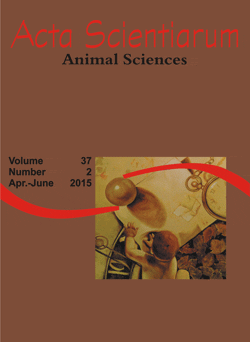<b>Glutamic acid supplementation on low protein diets for laying hens
Abstract
With the objective of evaluating the effect of reducing crude protein (CP) and L-glutamic acid supplementation, Dekalb Brown laying hens with 34 weeks of age. The birds were distributed in six treatments in a completely randomized design, eight replications of eight birds. The control diet contained 17% CP. The second and third treatments had CP reduced by 1.5 and 3.0 percentage points (pp) of CP in relation to the control diet, respectively. In the fourth treatment, was added the same amount of glutamate of the control diet (2.982%), and the last two treatments was added 1 and 2 pp of glutamate in relation to control diet (3.982 and 4.98%), respectively. The treatment with 15.17% CP + 0.341% L-glutamic acid (T4) promoted higher egg production, and the control diet showed greater egg weight than others treatments. There was no significant effect on the variables on quality of eggs. The T4 presented values of excreted nitrogen similar to the others treatments, with lower concentration of uric acid than the control diet and lower cost in the production. In conclusion, it is recommended the treatment with 15.17% CP + 0.341% L-glutamic acid for Brown laying hens with 34 weeks of age.
Downloads
References
AFTAB, U.; ASHRAF, M.; JIANG, Z. Low protein diets for broilers. World's Poultry Science Journal, v. 62, n. 04, p. 688-701, 2006.
BENEZ, S. M. Aves: criação, clinica, teoria, prática: silvestres,ornamentais, avinhados. 4nd ed. Ribeirão Preto, SP: Tecmedd. 2004.
BERRES, J.; VIEIRA, S. L.; DOZIER III, W. A.; CORTÊS, M. E. M.; BARROS, R.; NOGUEIRA, E. T.; KUTSCHENKO, M. Broiler responses toreduced-protein diets supplemented with valine, isoleucine, Glycine, and glutamic acid. Journal of Applied Poultry Research, v.19, n.01, p.68-79, 2010.
BURRIN, D. G.; STOLL, B. Metabolic fate and function of dietary glutamate in the gut. American Journal of Clinical Nutrition, v. 90, n. 3, p. 850-856, 2009.
DEAN, D. W.; BIDNER, T. D.; SOUTHERN, L. L. Glycine supplementation to low protein, amino acid-supplemented diets supports optimal performance of broiler chicks. Poultry Science, v. 85, n.2, p. 288–296, 2006.
FURUYA, W. M.; BOTARO, D.; MACEDO, R. M. G.; SANTOS, V. G.; SILVA, L. C. R.; SILVA, T. C.; FURUYA, V. R. B.; SALES, P. J. P. Aplicação do conceito de proteína ideal para redução dos níveis de proteína em dietas para tilápia-do-nilo (Oreochromisniloticus). Revista Brasileira de Zootecnia, v. 34, n. 5, 2005.
ISHIBASHI, T.; YONEMOCHI, C. Amino acid nutrition in egg production industry. JournalAnimal Science, v. 74, n. 6, p. 457-469, 2003.
KANEKO, J. J.; HARVEY, J. W.; BRUSS, M. L. Clinical biochemistry of domestics animals. 6nded. New York: Academic Press, 2008.
LI P.; YIN, Y. L.; LI, D. F.; KIM, S. W.; WU, G. Amino acids and immune function. British Journal of Nutrition, v. 98, n. 2, p. 237-252, 2007.
PAVAN, A. C.; MORI, C.; GARCIA, E. A.; SCHERER, R. S.; PIZZOLANTE, C. C. Níveis de proteína bruta e aminoácidos sulfurados totais sobre o desempenho, a qualidade dos ovos e a excreção de nitrogênio de poedeiras de ovos marrons. Revista Brasileira de Zootecnia, v. 34, n. 2, p. 568-574, 2005.
PESTI, G. M.; BAKALLI, R. I.; DRIVER, J. P.; ATENDIO, A.; FOSTER, E. H. Poultry nutrition and feeding. Victoria, BC: Trafford Publishing, 2005.
ROCHA, T. C.; GOMES, P. C.; DONZELE, J. L.; BARRETO, S. L. T.; MELLO, H. H. C.; BRUMANO, G.Níveis de lisina digestível em rações para poedeiras no período de 24 a 40 semanas de idade. Revista Brasileira de Zootecnia,v. 38, n. 9, p. 1726-1731, 2009.
ROSTAGNO, H. S.; ALBINO, L. F. T.; DONZELE, J. L. Tabelas brasileiras para aves e suínos: Composição de alimentos e exigências nutricionais de aves e suínos. 2nd ed. Viçosa, MG: Editora UFV, 2005.
SAS - STATISTICAL ANALYSIS SYSTEM.SAS software: user's guide. Version 8.2. Cary: NC, 2004.
SCHMIDT, E.; LOCATELLI-DITTRICH, R.; SANTIN, E.; PAULILLO, A. Patologia clínica em aves de produção: uma ferramenta para monitorar a sanidade avícola – revisão. Archives of Veterinary Science, v. 12, n. 3, p. 9-20, 2007.
SILVA, D. J.; QUEIROZ, A. C. Análise de alimentos: Métodos químicos e biológicos. 3nd ed. Viçosa, MG: Editora UFV, 2002.
SILVERSIDES, F. G.; TWIZEYIMANA, F.; VILLENEUVE, P. Research note: a study relating to the validity of the haugh unit correction for egg weight in fresh eggs. Poultry Science, v. 72, n. 4, p. 760-764, 1993.
DECLARATION OF ORIGINALITY AND COPYRIGHTS
- I Declare that current article is original and has not been submitted for publication, in part or in whole, to any other national or international journal.
The copyrights belong exclusively to the authors. Published content is licensed under Creative Commons Attribution 4.0 (CC BY 4.0) guidelines, which allows sharing (copy and distribution of the material in any medium or format) and adaptation (remix, transform, and build upon the material) for any purpose, even commercially, under the terms of attribution.
Read this link for further information on how to use CC BY 4.0 properly.








































